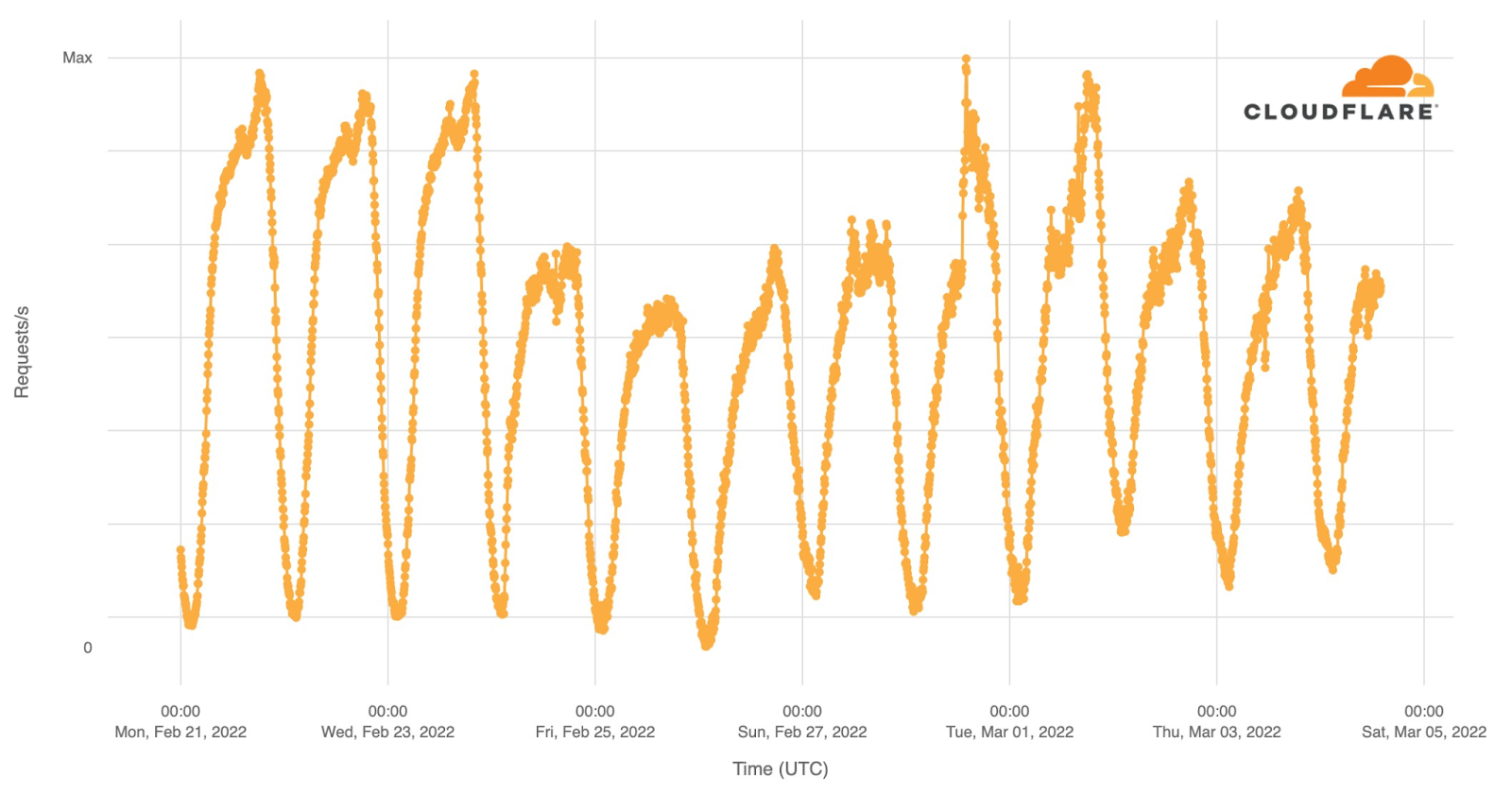Heavy Networking 620: High Frequency Trading And Big Data Network Design
Network design for high frequency trading and big data networks is the topic of today’s Heavy Networking. If you’re interested in what it’s like to carefully manage data center latency and maintain your sanity in a zero downtime environment, this is your show. Our guests are are Jeremy Filliben and Marc Washco of Jump Trading.Enterprises Need To Prepare for Broader Cyberwar
Russia has a long history of using cyberattacks against its enemies.Shields up: free Cloudflare services to improve your cyber readiness

Since our founding, Cloudflare's mission has been to "help build a better Internet," and we take it to heart. It used to be that the services required to adequately secure an online presence were only available to the largest of enterprises — organizations big enough to afford both the technology itself and the teams to manage it.
We've worked hard over the years to level the playing field. This has meant making more and more of the essential tools for protecting an online presence available to as many people as possible. Cloudflare offers unmetered DDoS protection — for free. We were the first to introduce SSL at scale — for free. And it’s not just protection for your external-facing infrastructure: we have a free Zero Trust plan that enables teams to protect their internal-facing infrastructure, too.
These types of tools have always been important for the billions of people on the Internet. But perhaps never as important as they've become this week.
Concurrent with the Russian invasion of Ukraine, we've seen increasing cyberattacks on the Internet, too. Governments around the world are encouraging organizations to go “shields up” — with warnings coming from the United States’ Cybersecurity & Infrastructure Security Continue reading
Internet traffic patterns in Ukraine since February 21, 2022

Cloudflare operates in more than 250 cities worldwide where we connect our equipment to the Internet to provide our broad range of services. We have data centers in Ukraine, Belarus and Russia and across the world. To operate our service we monitor traffic trends, performance and errors seen at each data center, aggregate data about DNS, and congestion and packet loss on Internet links.
Internet Traffic
For reference, here is a map of Ukraine showing its major cities. Note that whenever we talk about dates and times in this post, we are using UTC. Ukraine’s current time zone is UTC+2.

Internet traffic in Ukraine generally follows a pretty predictable pattern based on day and night. Lowest in the hours after local midnight and picking up as people wake up. It’s not uncommon to see a dip around lunchtime and a peak when people go home in the evening. That pattern is clearly visible in this chart of overall Internet traffic seen by Cloudflare for Ukrainian networks on Monday, Tuesday, and Wednesday prior to the invasion.

Starting Thursday, traffic was significantly lower. On Thursday, we saw about 70% of our normal request volume and about 60% on Friday. Continue reading
Video: Comparing TCP/IP and CLNP
If you were building networks in early 1990s you probably remember at least a half-dozen different network protocols. Only one of them survived (IPv6 came later), with another one (CLNP) providing an interesting view into a totally different parallel universe that evolved using a different set of fundamental principles.
After introducing the network-layer addressing, I compared the two and pointed out where one or the other was clearly better.
You might think that it makes no sense to talk about protocols that were rarely used in old days, and that are almost non-existent today, but as always those who cannot remember the past are doomed to repeat it, this time reinventing CLNP principles in IPv6-based layer-3-only data center fabrics.
Video: Comparing TCP/IP and CLNP
If you were building networks in early 1990s you probably remember at least a half-dozen different network protocols. Only one of them survived (IPv6 came later), with another one (CLNP) providing an interesting view into a totally different parallel universe that evolved using a different set of fundamental principles.
After introducing the network-layer addressing, I compared the two and pointed out where one or the other was clearly better.
You might think that it makes no sense to talk about protocols that were rarely used in old days, and that are almost non-existent today, but as always those who cannot remember the past are doomed to repeat it, this time reinventing CLNP principles in IPv6-based layer-3-only data center fabrics.
Cloud Engineering For The Network Pro: Part 4 – Virtual Subnets And Gateways (Video)
Part 4 of Michael Levan’s cloud networking series provides step-by-step instructions for setting up virtual subnets and Internet gateways in AWS and Azure. You can subscribe to the Packet Pushers’ YouTube channel for more videos as they are published. It’s a diverse a mix of content from Ethan and Greg, plus selected videos from our […]
The post Cloud Engineering For The Network Pro: Part 4 – Virtual Subnets And Gateways (Video) appeared first on Packet Pushers.
How to maximize K3s resource efficiency using Calico’s eBPF data plane
Amazon’s custom-built Graviton processor allows users to create ARM instances in the AWS public cloud, and Rancher K3s is an excellent way to run Kubernetes in these instances. By allowing a lightweight implementation of Kubernetes optimized for ARM with a single binary, K3s simplifies the cluster initialization process down to executing a simple command.
In an earlier article, I discussed how ARM architecture is becoming a rival to x86 in cloud computing, and steps that can be taken to leverage this situation and be prepared for this new era. Following the same narrative, in this article I’ll look at an example of the Calico eBPF data plane running on AWS, using Terraform to bootstrap our install to AWS, and Rancher K3s to deploy the cluster.
A few changes to Calico are needed for ARM compatibility, including updating parts, enabling eBPF, and compiling operators for the ARM64 environment:.
- Tigera Operator – Tigera Operator is the recommended way to install Calico.
- go-build – go-build is a container environment packed with all the utilities that Calico requires in its compilation process.
- Calico-node – Calico-node is the pod that hosts Felix (i.e. it is the brain that carries control plane decisions fto Continue reading
Syslog to Telegram
Introduction
From time to time, I wish I could be made aware of failures earlier. There are two events, in particular, that I am interested to know about very quickly, as they may impact service at AS8298:
- Open Shortest Path First (OSPF) adjacency removals. OSPF is a link-state protocol and it knows when a physical link goes down, that the peer (neighbor) is no longer reachable. It can then recompute paths to other routers fairly quickly. But if the link stays up but connectivity is interrupted, for example because there is a switch in the path, it can take a relatively long time to detect.
- Bidirectional Forwarding Detection (BFD) session timeouts. BFD sets up a rapid (for example every 50ms or 20Hz) of a unidirectional UDP stream between two hosts. If a number of packets (for example 40 packets or 2 seconds) are not received, a link can be assumed to be dead.
Notably, BIRD, as many other vendors do, can combine the two. At IPng, each OSPF adjacency is protected by BFD. What happens is that once an OSPF enabled link comes up, OSPF Hello packets will be periodically transmitted (with a period called called a Hello Timer Continue reading
Hedge 120: Information Centric Networking with Dirk Kutscher
In today’s Internet,
Join Dirk Kutscher, Alvaro Retana, and Russ White, as they discuss this interesting research area at the future edge of networking. You can find out more about ICN here.